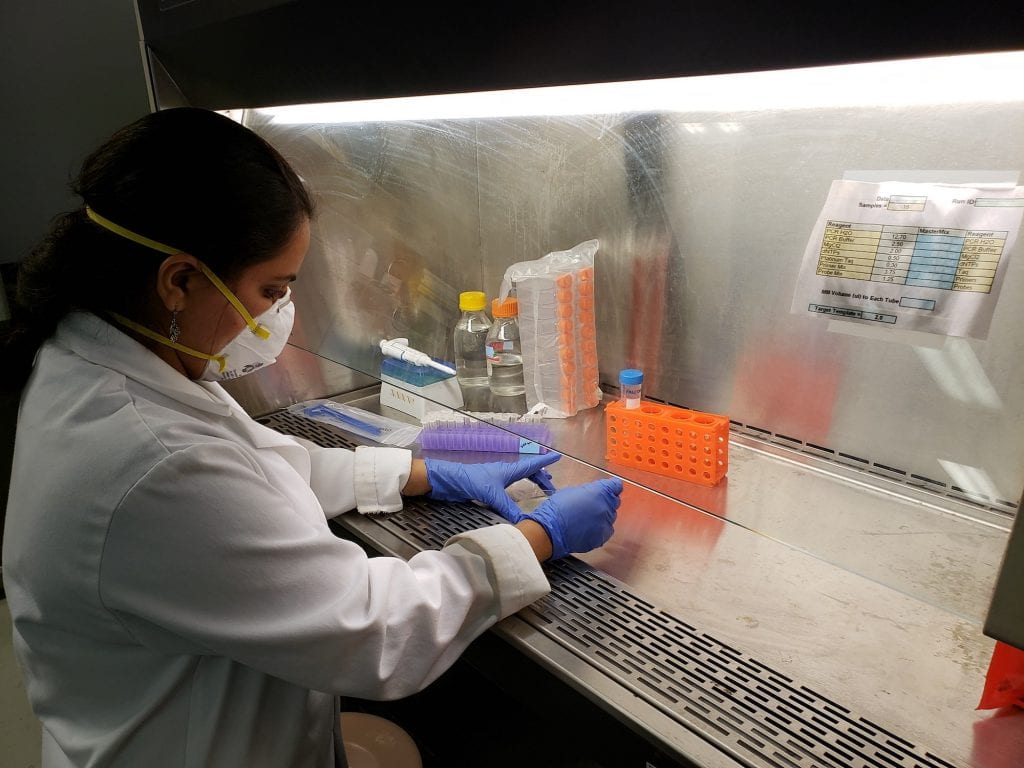From the delivery of an Amazon package to ordering takeout food, people touch a multitude of surfaces every day, leaving behind residue, germs, and more. Food supply chain personnel from every level – growing, processing, distribution, and retail – are constantly in contact with a variety of surfaces.
Virginia Tech researchers are studying how long SARS-CoV-2 survives on surfaces, focusing on its survival on food, food contact surfaces, and other points along the food supply chain.
With a two-year, $1 million grant from the USDA National Institute of Food and Agriculture, the research team will address such topics as how to ensure that someone won’t contract SARS-CoV-2 from handling packaging and how to properly sanitize at all levels of food distribution and production.
“Our knowledge about SARS-CoV-2 virus’ survival on foods and food contact surfaces, and in response to different disinfection methods, is very limited,” said Reza Ovissipour, primary investigator on the project and an assistant professor in food science and technology and the Virginia Seafood Agricultural Research and Experiment Center and a Virginia Cooperative Extension specialist. “The fate of the virus and how it can be transferred through the food supply chain has not been addressed yet. Thus, these significant limitations highlighted the unmet needs to develop systematic research approaches and training materials for industry. Based on this systematic approach, adaptable strategies will be developed across the food and agriculture industry to rapidly respond to the COVID-19 pandemic.”
The food supply chain was negatively impacted during the early stages of the COVID-19 pandemic, experiencing a 10 percent reduction in pork production and a 25 percent decrease in beef production. These two areas, along with others, resulted in some food insecurity concerns.
After the completion of the study, stakeholders at all levels of the food supply chain will have access to materials that provide a wide-ranging, systematic approach to safety, detailing steps that should be taken to ensure the health and safety of everyone involved, ensuring that the food supply chain is resilient now and in the future.

The team will conduct their research in a BSL-3 lab on Virginia Tech campus with live samples of SARS-CoV-2, the virus that causes COVID-19.
“We are a fortunate group that has access to the live virus,” Ovissipour said. “One of the challenges of this lab setting is how we can mimic real situations that we have in the food industry or the supply chain inside of a BSL-3 lab setting due to limited space and safety concerns.”
To meet that challenge, the research team also has a pseudotyped virus that mimics many of the same characteristics of the COVID-19 virus, but is not pathogenic, allowing for more freedom and safety in their research.
Some of the environments that will be simulated in the lab are different levels of humidity, temperatures, acidity levels, water activity, and surface properties, to determine if typical conditions involved in food packaging and handling impact the survivability of the virus. In addition, the lab will be testing common and novel food-grade sanitization methods to destroy the virus.
“This project examines the fate of the virus in all steps in the food supply chain – literally from farm to table,” said Andrea Bertke, a virologist and an associate professor in the Department of Population Health Sciences in the Virginia-Maryland College of Veterinary Medicine at Virginia Tech. “My lab focuses mostly on how viruses cause disease, so this is a very interesting project for us, providing an opportunity to impact public health in a different way.”
Another aspect of the food industry is transportation and shipping, mainly the materials in which food is packaged. Survivability of the virus on materials, such as Styrofoam, cellophane, and more, will be tested.
Based on the outcome of the research, sanitation recommendations will be made for food and agriculture sectors.


